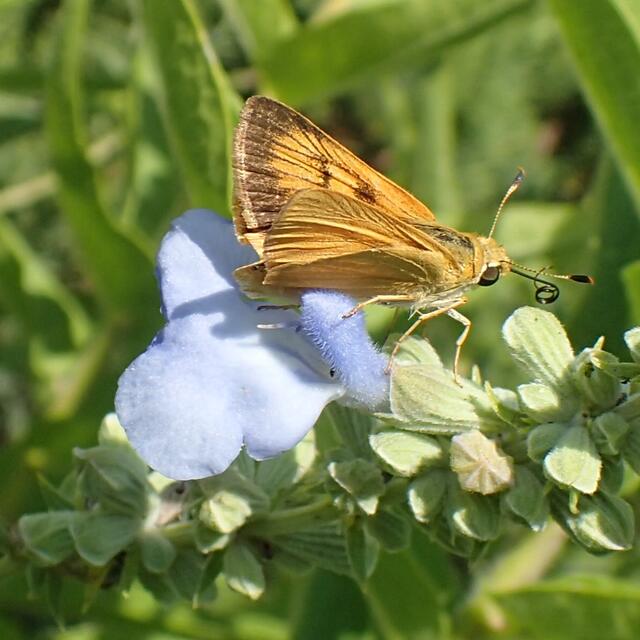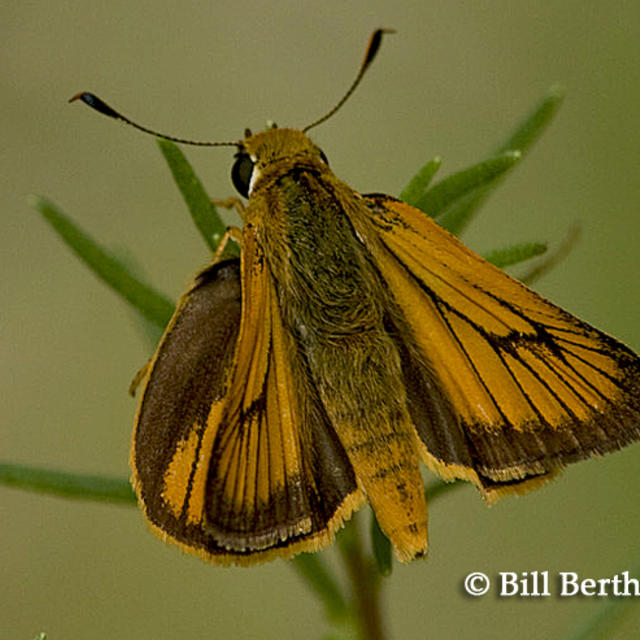Delaware Skipper
Anatrytone logan (W.H. Edwards, 1863)
Family: Hesperiidae
Subfamily: Hesperiinae
Identification: Wings are bright yellow-orange. Upperside has black borders and black veins near the margins; forewing has a black bar at the end of the cell. Females have wider borders and darker markings than males. Underside has no markings but may have darker orange veins.
Wing Span: 1 - 1 11/16 inches (2.5 - 4.3 cm).
Life History: Males perch within 1 1/2 feet of the ground in open, grassy areas or along streams to await receptive females. Females deposit eggs singly on host plant leaves. Caterpillars eat leaves and use them to make nests.
Flight: One brood from July-August in the north; two broods from May-September in the south; several broods from February-October in Florida.
Caterpillar Hosts: Various grasses including big bluestem (Andropogon gerardi), switchgrass (Panicum virgatum), and wooly beard grass (Erianthus divaricatus).
Adult Food: Nectar from pink and white flowers including swamp and common milkweeds, shrub houstonia, mountain mint, marsh fleabane, sweet pepperbush, buttonbush, thistles, and pickerelweed.
Habitat: Moist areas including marshes, prairies, fields, roadsides, suburban yards.
Range: Southern Maine west across the Great Lakes states and southern Canada to central Montana; south to Florida, the Gulf states, Texas, northeastern New Mexico, and the Mexican highlands to El Salvador.
Conservation: Not usually required.
NCGR: G5 - Demonstrably secure globally, though it may be quite rare in parts of its range, especially at the periphery.
Management Needs: None reported.
Comments: NULL
Get your BAMONA Gear!
Please donate!
We depend on donations to keep Butterflies and Moths of North America freely available. We want to express our gratitude to all who showed their support by making a contribution this year. You can donate to support this project at any time.
Advertise with us!
Do you have a product or service that you think would interest BAMONA users? If you would like to advertise on this website, contact us by email, or use the contact form and select the "Advertising" category.
Verified Sightings
Displaying 1 - 24 of 2618 verified sightings

Observation date: Aug 07, 2024
Submitted by: Lisahug
Region: Buffalo County, Nebraska, United States
Verified by: Emily Geest
Verified date: Feb 10, 2025

Observation date: Jul 19, 2024
Submitted by: Victoire Batiste
Region: Mercer County, New Jersey, United States
Verified by: John Calhoun
Verified date: Jan 03, 2025

Observation date: Aug 17, 2024
Submitted by: wallap74
Region: St. Martin Parish, Louisiana, United States
Verified by: CA Ivy
Verified date: Aug 21, 2024

Observation date: Jul 07, 2024
Submitted by: dvollmar
Region: Wright County, Minnesota, United States
Verified by: jmgesell
Verified date: Aug 07, 2024

Observation date: Jul 28, 2024
Submitted by: Reedberg
Region: Pettis County, Missouri, United States
Verified by: CA Ivy
Verified date: Aug 05, 2024

Observation date: Jul 27, 2024
Submitted by: bjones7777
Region: Lauderdale County, Tennessee, United States
Verified by: James Steen
Verified date: Jul 28, 2024

Observation date: Jul 26, 2024
Submitted by: tedzimmerman
Region: Norfolk County, Massachusetts, United States
Verified by: jwileyrains
Verified date: Jul 26, 2024

Observation date: Jun 29, 2024
Submitted by: lhinderlider
Region: Boulder County, Colorado, United States
Verified by: mikefisher
Verified date: Jul 25, 2024

Observation date: Jul 19, 2024
Submitted by: DeepSkyKelly
Region: Union County, New Mexico, United States
Verified by: stevecary
Verified date: Jul 24, 2024

Observation date: Jul 05, 2023
Submitted by: Tom Dudones
Region: Essex County, New York, United States
Verified by: jmgesell
Verified date: Jul 16, 2024

Observation date: Jul 13, 2024
Submitted by: drmarc60223
Region: Buffalo County, Wisconsin, United States
Verified by: jmgesell
Verified date: Jul 16, 2024

Observation date: Jul 11, 2024
Submitted by: Puccini
Region: Roberts County, South Dakota, United States
Verified by: J_Martineau
Verified date: Jul 16, 2024

Observation date: Jul 12, 2024
Submitted by: rapids
Region: Ontario, Canada
Verified by: jmgesell
Verified date: Jul 13, 2024

Observation date: Jul 09, 2024
Submitted by: rapids
Region: Ontario, Canada
Verified by: jmgesell
Verified date: Jul 10, 2024

Observation date: Jun 26, 2024
Submitted by: naj.pilla
Region: Brule County, South Dakota, United States
Verified by: J_Martineau
Verified date: Jul 08, 2024

Observation date: Jul 04, 2024
Submitted by: Benjamin Miller
Region: Knox County, Ohio, United States
Verified by: rogerdowner
Verified date: Jul 05, 2024

Observation date: Jul 01, 2024
Submitted by: jmgesell
Region: Monroe County, Pennsylvania, United States
Verified by: davidwright
Verified date: Jul 04, 2024

Observation date: Jul 02, 2024
Submitted by: garyfreed
Region: Montgomery County, Pennsylvania, United States
Verified by: davidwright
Verified date: Jul 03, 2024

Observation date: Jun 24, 2024
Submitted by: Benjamin Miller
Region: Knox County, Ohio, United States
Verified by: rogerdowner
Verified date: Jun 29, 2024

Observation date: Jun 09, 2024
Submitted by: seemayer
Region: Sedgwick County, Kansas, United States
Verified by: James Steen
Verified date: Jun 19, 2024

Observation date: May 25, 2024
Submitted by: Ozark_Bill
Region: Phelps County, Missouri, United States
Verified by: CA Ivy
Verified date: Jun 06, 2024

Observation date: Apr 05, 2024
Submitted by: Pkleinsasser
Region: Flagler County, Florida, United States
Verified by: John Calhoun
Verified date: Apr 08, 2024

Observation date: Sep 07, 2023
Submitted by: seemayer
Region: Sedgwick County, Kansas, United States
Verified by: James Steen
Verified date: Apr 02, 2024

Observation date: Oct 10, 2023
Submitted by: jehartg
Region: East Baton Rouge Parish, Louisiana, United States
Verified by: CA Ivy
Verified date: Oct 13, 2023
- 1 of 110
- next ›










